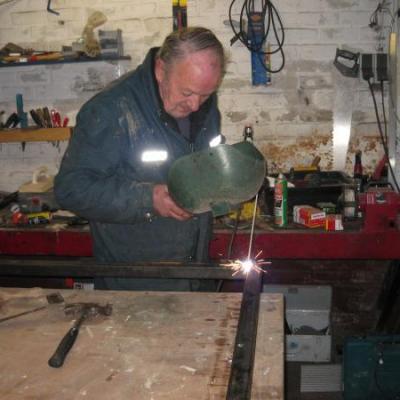Welder (Lasser)
Information on this skill...
A welder is responsible for welding metal objects together, by applying heat or pressure. If a welder has mastered various welding techniques, the term all-round welder applies. In all cases, welding is only possible by applying heat or pressure. Due to the heat or pressure generated, the material will liquefy and the weld will be created. A big advantage of welding is that it creates a permanent connection that is strong. A disadvantage of welding is that made connections are difficult to disassemble. Welders are responsible for small-scale welding work and not for production work, because production work can be carried out fully or partially automatically. In welding, the quality of welding plays an important role, because welded joints must meet quality requirements. Think, for example, of pipelines or building constructions, which may not fail. If welding is to be very reliable, non-destructive testing can be used. In case of non-destructive testing, the welding work will be inspected with equipment for errors that are not visible to the naked eye. Welding officially belongs to mechanical engineering, but welders occur in almost all branches. Learning to weld neatly is a matter of practice and building experience. Depending on the welding work, a welder may need to have different training and certifications in order to work as a welder. As a welder, it is important that you can read your drawing and that you understand how components should be built. Material knowledge also plays an important role as a welder. Think of applying the right welding technique, so that workpieces cannot warp due to welding. Another important point is personal safety. Think of the prevention of welding eyes and not inhaling welding fumes.
A welder is therefore responsible for making welded joints by applying different welding techniques. It is not the case that only metalworkers have to deal with welding work. Think, for example, of car mechanics, who can regularly have to deal with welding work. This usually relates to replacing body pieces so that a vehicle passes the MOT. Metalworkers who have a lot to do with welding work are, for example, pipe fitters, construction bench workers, coachbuilders and frame builders. Depending on the work, a welder may have to deal with different welding techniques. Think of arc welding (MIG/MAG and TIG welding), dru classes (spot welding and dru classes) and plasma welding. In all these different welding techniques, heat or pressure is used to make a connection possible. This is an important difference with soldering work. Soldering involves adding material to enable a connection. If welding work must be of high quality, there is in the case of bundle welding. Bundle welding usually relates to mechanical engineering, aircraft industry or the oil and gas industry. Bundle welding may involve non-destructive testing to check quality.
WORKING AS A WELDER
As a welder, it is important that you have sufficient professional knowledge. The professional knowledge of a welder does not only relate to the ability to set up welding machines. Also think of using the right welding speed and being able to estimate the heat applied. When too much heat is introduced, damage can occur to the workpiece. Think of warping the workpiece or causing hairline cracks. To prevent warping or hairline cracks, it may be important that the welder will first preheat the workpiece. Due to preheating, the temperature difference is less large, minimizing the chance of warping or hairline cracks. Even after welding, it can be important to use warming blankets. As described earlier, welding occurs in practice in many ways. Consider, for example, assembly technicians, who are responsible for manually welding structures. In that case, it is usually not possible to weld automatically by means of welding robots.
SAFETY DURING WELDING
As a welder, it is important in all cases to pay attention to personal safety. When welding, many metal spatters are released, making wearing safety clothing important. A welder should therefore wear gloves and possibly a protective apron. What should never be missing during welding is a welding cap. Without a welding hood, a welder gets welding eyes. Welding eyes are not only very annoying but also very painful. Professional welders are regularly examined by a company doctor. This mainly relates to investigating whether welders are not harmed by welding fumes. Welding fumes can cause headaches, nausea, skin irritation, dizziness and metal vapor fever. To prevent damage from welding fumes, it is important that welders use breathing equipment or professional welding extraction.
ADVANTAGES OF WELDING:
- A weld does not cause weakening of the structure;
- A welding connection can withstand high temperature changes;
- A weld has little resistance (inside tubes);
- A welding connection can be made quickly;
- A weld is resistant to high temperatures;
- A welding connection is strong.
DISADVANTAGES OF WELDING:
- A welding joint can affect the properties of material (strength and hardness);
- A welding connection is only possible with materials with the same properties;
- A welding connection can cause hairline cracks (expanding and shrinking);
- A welding connection can cause the workpiece to warp due to the heat;
- A weld connection cannot be easily loosened.
WHAT DOES A WELDER DO?
The profession of welder essentially consists of welding different pieces of metal together. The welder does this by heating the metal to a temperature where the molecules are in a state of fusion and thereby connect to a compound. Welders also use machines such as grinders and cutting torches to ensure that the pieces of metal fit together perfectly.
The core of a welder's work is burning, in which metals are heated to a temperature high enough to make them deformable. While most welding projects involve having two pieces of metal in front of you, some welders work on large projects that require metal sheets to be glued together. In that case, the industry also speaks of welding glue.
DIFFERENT WELDING TECHNIQUES
Metal parts can be welded by means of various welding techniques. Nowadays there are many welding techniques that all have their own advantages and disadvantages. In addition, the welding technique used is highly dependent on the metal parts that need to be welded. This can also depend on the thickness of the metal. Thin metal welding is very different from welding thick sheet material.
- TIG welding is a manual welding process that requires a high level of the TIG welder. The TIG welder uses a special welding torch in combination with an electrode to establish the connection. In most TIG welding projects, the workpieces are made of aluminum, steel or stainless steel. TIG stands for 'Tungsten Inert Gas', which means that the tungsten is surrounded by inert gas (argon) during the process. Thus, TIG welding involves a manual welding process.
- MIG welding is an automated welding process that uses a wire feeder to feed the welding metal. The welder usually uses a shielding gas such as carbon dioxide or argon to protect the melt pool from contaminants. The abbreviation MIG stands for 'Metal InertGas'. MIG welding is widely used in stainless steel and aluminium welding.
- The most common welding process is autogenous welding. In autogenous welding, the welder uses a flame to heat the metal parts to be welded. The autogenous welds then connect the pieces of metal by melting them and adding filling metal to them. Autogenous welding is often used to weld thin metals, as it allows good control of the heat.
THE USE OF A WELDING MACHINE
In many industries, such as construction, automotive, manufacturing and engineering, welding machines are in high demand. They are used to weld different pieces of metal together, creating strong bonds. A welder must be able to read drawings and welding symbols to understand the requirements of the project. In addition, the welder must be able to choose the right welding process and the right welding equipment for the project.
Welders must be able to work in a safe and efficient manner. They must also be able to weld a variety of metals, including aluminum, steel and stainless steel. The welder must be able to adapt to new technologies and processes. Welding car parts can also occur within the profession of welder. In that case, it can be different car parts or the bodywork. Working as a welder requires the right professional knowledge. With a targeted MBO education, you can work as a welder in different ways.
WHAT DOES A WELDER DO:
TRAINING TO BECOME A WELDER
If you aspire to a career as a welder, it is best to opt for the MBO training all-round welder. Most training courses for all-round welders go up to level three, after which you can follow additional courses and training. Depending on your previous education, the training to become an all-round welder will take an average of two years. During the training you will learn, among other things, how to prepare welds, measure, material knowledge, professional knowledge and welding. As a welder, you will in most cases follow a practice-oriented training, in which you work under the supervision of an experienced colleague, who in that case can be regarded as your teacher. In addition, there are also plenty of external training institutes where you can follow a course. Accounting is also important as an entrepreneur.
COMPANIES WHERE A WELDER CAN BE EMPLOYED
A welder can work for various companies that have to do with welding work. Think, for example, of tank container mechanics, shipbuilders, machine builders and construction companies. In addition, a welder can work for the offshore industry. In that case, a welder can be regarded as a professional diver and you are responsible for carrying out welding work under water. To be allowed to weld underwater, you will have to have additional training and certification. A welder does not have to work full-time, because most welders are also employed for other work, depending on the company where he or she works. It is conceivable that an experienced all-round welder works as an entrepreneur.
COMPETENCES WELDER
The most important competence of a welder is the professional knowledge. The profession of welder does not only relate to being able to weld. Also think of material knowledge, reading drawings, dimensions and standards that a welder has to deal with. In addition, you must work in a safe way, without, for example, inhaling too many fumes. Another important competence is that you can be classified as an all-round mechanic and technician, because welders have to deal with different techniques and assembly work. Because most welders work with different colleagues, you will also need to have good communication skills. Generally important words are cooperation, knowledge, further training, planning, organizing, inspecting, sense of responsibility and accuracy.
LABOUR MARKET PERSPECTIVE AND CAREER OPPORTUNITIES AS A WELDER
The labour market perspective of an all-round welder is good. There is a lot of demand for all-round welders by various companies. However, it may be important that you have additional training and certification. The career opportunities of a welder should be seen in obtaining more responsibilities. Think, for example, of working as a chef's workshop or of training and supervising new welders.
TERMS OF EMPLOYMENT AND SALARY WELDER
In most cases, a welder will fall under the collective labour agreement for metal and technology, in which the employment conditions are regulated depending on the employer. A welder will in most cases earn a salary between 2000 and 2500 euros gross per month, depending on age, education and further responsibilities. If a laser works within the offshore industry, the salary can be much higher.
The content on this page has been automatically translated from the Dutch language. For this reason, texts and videos on this page may contain small errors.
Lesen Sie diese Informationen auf Schweiber auf Deutsch.
Lea esta información sobre Soldador en español.
Lees deze informatie over Lasser in het Nederlands.
Mijnzzp.nl


